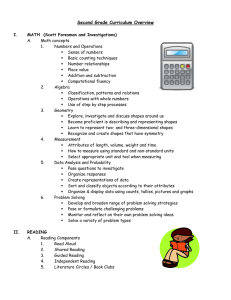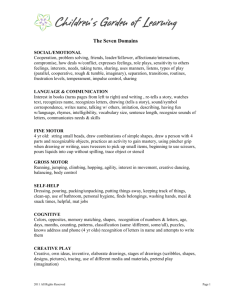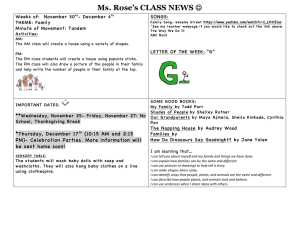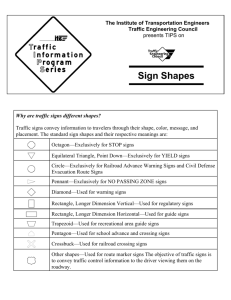For teachers
advertisement
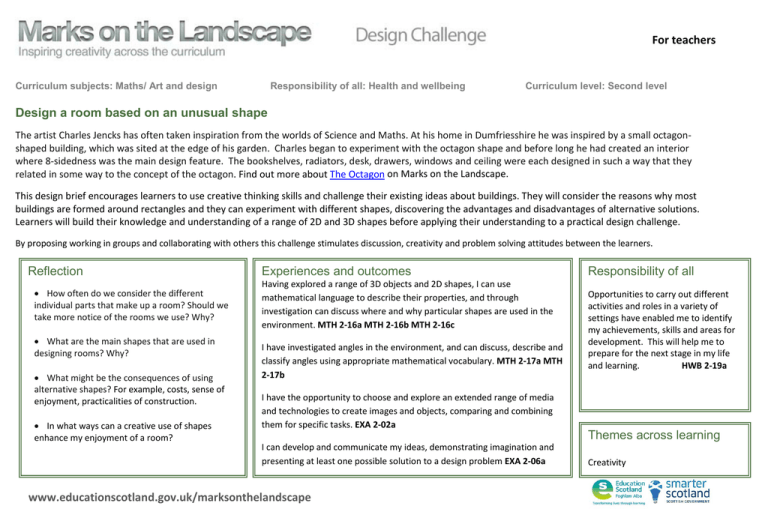
For teachers Curriculum subjects: Maths/ Art and design Responsibility of all: Health and wellbeing Curriculum level: Second level Design a room based on an unusual shape The artist Charles Jencks has often taken inspiration from the worlds of Science and Maths. At his home in Dumfriesshire he was inspired by a small octagonshaped building, which was sited at the edge of his garden. Charles began to experiment with the octagon shape and before long he had created an interior where 8-sidedness was the main design feature. The bookshelves, radiators, desk, drawers, windows and ceiling were each designed in such a way that they related in some way to the concept of the octagon. Find out more about The Octagon on Marks on the Landscape. This design brief encourages learners to use creative thinking skills and challenge their existing ideas about buildings. They will consider the reasons why most buildings are formed around rectangles and they can experiment with different shapes, discovering the advantages and disadvantages of alternative solutions. Learners will build their knowledge and understanding of a range of 2D and 3D shapes before applying their understanding to a practical design challenge. By proposing working in groups and collaborating with others this challenge stimulates discussion, creativity and problem solving attitudes between the learners. Reflection • How often do we consider the different individual parts that make up a room? Should we take more notice of the rooms we use? Why? • What are the main shapes that are used in designing rooms? Why? • What might be the consequences of using alternative shapes? For example, costs, sense of enjoyment, practicalities of construction. • In what ways can a creative use of shapes enhance my enjoyment of a room? Experiences and outcomes Having explored a range of 3D objects and 2D shapes, I can use mathematical language to describe their properties, and through investigation can discuss where and why particular shapes are used in the environment. MTH 2-16a MTH 2-16b MTH 2-16c I have investigated angles in the environment, and can discuss, describe and classify angles using appropriate mathematical vocabulary. MTH 2-17a MTH 2-17b I have the opportunity to choose and explore an extended range of media and technologies to create images and objects, comparing and combining them for specific tasks. EXA 2-02a I can develop and communicate my ideas, demonstrating imagination and presenting at least one possible solution to a design problem EXA 2-06a www.educationscotland.gov.uk/marksonthelandscape Responsibility of all Opportunities to carry out different activities and roles in a variety of settings have enabled me to identify my achievements, skills and areas for development. This will help me to prepare for the next stage in my life and learning. HWB 2-19a Themes across learning Creativity For teachers The design process The design process can be complex depending on the specific industry. For the purposes of this resource it has been simplified in the three sections below: Research, Create, Evaluate. The sub-headings suggest the types of transferable skills and experiences that may be relevant to the design challenge although the lists are not exhaustive. The sample activities relate to the specific challenge but they should be expanded as part of the collaborative planning process with pupils. The experiences and outcomes provide a starting point for discussions with learners to identify learning intentions and success criteria. Evaluate Research Create Define the problem, analyse the brief, investigate the theme, manage information Ask questions, generate ideas, use imagination, identify solutions, develop the design, solve problems, take risks Ask questions, revisit the brief, judge value, modify, communicate, present Sample activities Sample activities Sample activities Sample activities • • • • • • Form design teams and find out about and assume different roles and responsibilities. Discuss the challenge, plan what needs to be done and how you will know if it is successful. Research a range of different types of unusual buildings and rooms Explore a range of mathematical shapes and discuss their properties and match them to the shapes used in parts of rooms Experiment with how the shapes come together and discuss the angles within them and between them and other shapes. Invite an architect into the school to discuss how to go about making an unusually-shaped room. Working as part of a design team learners can: • • • • • • Make a list of success criteria for the room based on where it might be, who might use it and for what purpose. Use magnetic construction materials to create a 3D room Use a mathematical shape ‘net’ to create a 3D space in cardboard. Use imagination to experiment with all the different uses the shape can have in the room, eg lighting, seating, storage, decoration, fabrics Use a range of different materials and select the best one for each function. If you have access to 3D modelling software, experiment with different solutions www.educationscotland.gov.uk/marksonthelandscape Devise questions to help you decide how effective your design is, for example: • • • • • Does it fulfil your success criteria and challenge your users? Have you used your imagination and tried to solve problems in different ways? Is your room innovative? Is it well presented? Could it be improved in any way? Design teams can present their rooms to others and gain feedback through a points system and through oral feedback. For pupils The Design Brief Design and make a room based on a mathematical shape other than a rectangle. You should research a range of different shapes before deciding on the best one for your task. You will need to learn about the properties of your shape; think about its sides and angles. When you are familiar with your shape, try to use it to make a 3-d form. Use your imagination and experiment with all the different ways you could use your shape in a room design. Working as part of a design team, discuss what will make your design successful. You may want to consider: • • • • Who will use the room and what style they might like What the room will be used for, for example, relaxing, working, eating or for displaying things like a gallery or a shop What will you need to include in your room and can any of these things be made from your selected shape Can your room be environmentally friendly With your team discuss how you will manage your project and who will undertake the main tasks. You will need to research, experiment, ask questions, solve problems and make decisions. You should also think about how you will present your room to other people. Will you show a model, design board or a computer presentation? You may find it helpful to use a ‘design process’ template to develop your ideas. www.educationscotland.gov.uk/marksonthelandscape Resources Marks on the Landscape – Themes – The Octagon Information about The Octagon house that Charles Jencks uses as his library Images of 15 unusual and creative buildings Images of 15 unusual buildings from around the world A room for London: Unique Architectural Innovation An article about the smallest building on a rooftop that will be one of the major attractions during the beginning of the Olympic year of 2012 Roger’s Connection Magnetic Construction Toy Building strong shapes with triangles using magnetic construction materials


